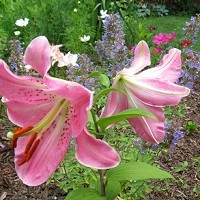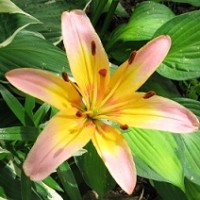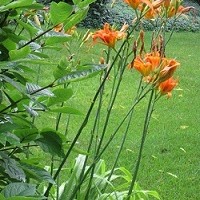What’s in a Name?
When I worked at Home Depot, there was always confusion when the Asiatic lilies went on sale. People would arrive at the registers with all kinds of things—calla lilies, day lilies, peace lilies, even lily of the Nile. What’s in a name? Aren’t all these things lilies?
Every plant has a common name which serves kind of like a nickname. But each plant also has a Latin name for classification purposes and this is what we rely upon most often to help us understand what plant we are discussing. Just as many children can be nicknamed Princess or Sport, our legal, given name is much more specific.
 Plants have a legal name, if you will, that consists of a genus (larger group) and species (subgroup). Beyond that, certain cultivated varieties (cultivars for short) will have a name in quotes which makes it even more specific. The Oriental lily Lilium ‘Farolito’ shown here is a cultivar. Lilium x ‘Kiss Me Kate’ would be a hybrid lily denoted by an ‘x’ to show that it is a cross between a longiflorum lily (like an Easter lily) and an Asiatic lily.
Plants have a legal name, if you will, that consists of a genus (larger group) and species (subgroup). Beyond that, certain cultivated varieties (cultivars for short) will have a name in quotes which makes it even more specific. The Oriental lily Lilium ‘Farolito’ shown here is a cultivar. Lilium x ‘Kiss Me Kate’ would be a hybrid lily denoted by an ‘x’ to show that it is a cross between a longiflorum lily (like an Easter lily) and an Asiatic lily.
In the case of true lilies, there are types (Asiatic and Oriental, for example) both in the genus Lilium. Yet Asiatics will display similarities to each other because they are Asiatics. Each species within Asiatics will have different characteristics—flower colors, markings, fragrance, height, etc. Asiatic and Oriental lilies, being closely related (like siblings), have many features in common and can be hard to tell apart. There are a few web sites discussing the differences, often times that Asiatic lilies open upward and Oriental lilies open outward and are more highly fragrant. Beyond that, if I desire specifics, I look them up on the grower’s listing since it simplifies matters greatly.
Other plants we commonly call lilies are actually in different genus altogether. Calla lilies are in the genus Zantedeschia; Daylilies are Hemerocallis, Peace lilies are houseplants in the genus Spathiphyllum, Lily of the Nile is an Agapanthus. All are wonderful plants, but none of them are technically lilies.
And why do you worry about clothes? See how the lilies of the field grow. They do not labor or spin. Yet I tell you that not even Solomon in all his splendor was dressed like one of these. If that is how God clothes the grass of the field, which is here today and tomorrow is thrown into the fire, will he not much more clothe you, O you of little faith?” Matthew 6:28-30
What’s in a name? Quite a bit actually.

 They grow differently in form—lilies (pictured on the left) are flowers emerging atop leafy stalks, daylilies (right) form clumps. They originate from different structures—lilies arise from bulbs, daylilies grow from fibrous root systems that will enlarge into spindle-like roots resembling tubers. Lily flowers are long lasting and open from the lower buds to the upper buds. When the buds have all opened, the flowering is completed for the year. Daylilies, on the other hand, have a short bloom—each lasting only a day, hence daylily, however the season of bloom may be quite extensive. Lily bulbs must be planted at a sufficient depth to protect them from the harsh winters, but not so deep that the plant must struggle through an endless stretch to reach the soil surface. Daylilies are planted so the crown is at the soil level with the fibrous roots and tuberous spindles are stretched out just below the soil surface. Lilies will grow larger clumps by growing increasing bulb sizes as well as by dropping bulbils (present after bloom in the leaf axils) off the stem onto the ground. Daylilies, depending on variety, can be downright invasive…emerging anywhere there’s an opportunity within the range of the mother plant.
They grow differently in form—lilies (pictured on the left) are flowers emerging atop leafy stalks, daylilies (right) form clumps. They originate from different structures—lilies arise from bulbs, daylilies grow from fibrous root systems that will enlarge into spindle-like roots resembling tubers. Lily flowers are long lasting and open from the lower buds to the upper buds. When the buds have all opened, the flowering is completed for the year. Daylilies, on the other hand, have a short bloom—each lasting only a day, hence daylily, however the season of bloom may be quite extensive. Lily bulbs must be planted at a sufficient depth to protect them from the harsh winters, but not so deep that the plant must struggle through an endless stretch to reach the soil surface. Daylilies are planted so the crown is at the soil level with the fibrous roots and tuberous spindles are stretched out just below the soil surface. Lilies will grow larger clumps by growing increasing bulb sizes as well as by dropping bulbils (present after bloom in the leaf axils) off the stem onto the ground. Daylilies, depending on variety, can be downright invasive…emerging anywhere there’s an opportunity within the range of the mother plant.


Leave a Reply